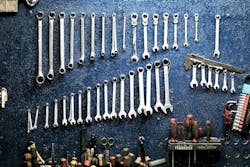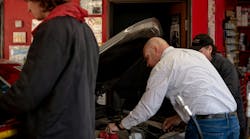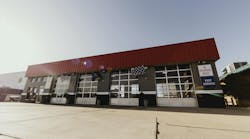The Ford Escape has been significantly updated for the 2017 model year. Ford added the latest driver-assist technologies, connectivity and two new EcoBoost engines.
Escape is the first Ford vehicle to make Auto Start-Stop technology standard with either of the two EcoBoost offerings — a 1.5-liter engine and a 2.0-liter twin-scroll. Auto Start-Stop shuts off the engine during common stops, so the vehicle burns no gas and emits zero tailpipe emissions, restarting automatically when the brake pedal is released.
Escape SE and Titanium trim levels come standard with the new 1.5-liter four-cylinder EcoBoost, while the powerful new twin-scroll 2.0-liter EcoBoost is optional. A six-speed automatic transmission is standard across the line, with new paddle-shift technology available for Escape SE and Titanium.
The twin-scroll turbocharged 2.0-liter EcoBoost delivers 245 horsepower and 275 pound-feet of torque, along with greater efficiency and improved noise, vibration and harshness performance. New pistons provide a higher, more efficient compression ratio, and a newly designed, integrated exhaust manifold is optimized for the twin-scroll turbo system.
The aluminum-block, twin-cam 1.5-liter EcoBoost with integrated exhaust manifold is projected to deliver horsepower and torque output comparable to the 1.6-liter — an expected 180 horsepower and 185 pound-feet of torque.
Along with the new EcoBoost offerings, the 2.5-liter i-VCT four-cylinder engine carries over as a standard equipment for the Escape S series.
Changes to the interior began with a new push-button electronic parking brake that replaces the large hand-actuated parking brake. The gear shifter has been repositioned rearward for improved access to climate controls on the center stack, and a media bin added at the bottom of the stack offers access to a USB port and covered power outlet.
With Sync Connect, owners can remotely start their vehicle and schedule future starts, as well as lock and unlock their Escape using their smartphones. The technology provides vehicle location, as well as key vehicle information such as tire pressures, battery and fuel levels.
In addition to such features as hands-free liftgate and Sync3, the new Escape offers these available technologies:
• Adaptive cruise control and collision warning with brake support uses sensors to detect a slow-moving vehicle in front and adjust cruise control accordingly • Sync Connect lets owners use the FordPass smartphone platform to start, lock, unlock and locate their vehicle • Enhanced active park assist provides automatic steering assistance to park the vehicle in a parallel or perpendicular parking spot, and pull out from tight parallel parking spots • Lane-keeping system includes lane-keeping assist, which alerts drivers when they drift unintentionally from their lane, as well as lane-keeping aid, which provides steering assistance to guide an unintentionally drifting vehicle back into its lane • Driver alert system uses data from the lane-keeping system to detect signs of fatigued driving — providing a warning on the instrument cluster Escape customers can continue to select from S, SE and Titanium trim levels, as well as a new Sport Appearance Package available for SE and Titanium. Charcoal Black with subtle Deep Space black trim is available for Escape Titanium. Salerno leather seats feature a unique horizontal pattern, and Titanium customers can also opt for Medium Stone seats to contrast with the black interior. Escape will be offered in three new colors — Canyon Ridge, White Gold and Lightning Blue. Six new wheel designs are also available. An entry-level S trim Escape carries a starting MSRP of $23,750. A top-of-the-line Titanium Escape with a 2.0-liter EcoBoost engine, four-wheel drive, class II trailer tow prep package, the Titanium technology package and panoramic vista roof will cost a driver just over $35,000.
Servicing the Escape The 2017 Ford Escape is equipped with the Intelligent Oil-Life Monitor system, which displays a message in the information display at the proper oil change interval. This interval may be up to one year or 10,000 miles (16,000 km). When the oil change message appears in the information display, it is time for an oil change, which should be performed within two weeks or 500 miles (800 km) of the message appearing.
If the information display resets prematurely or becomes inoperative, oil changes should be performed every six months or 5,000 miles (8,000 km). Never exceed one year or 10,000 miles (16,000 km) between oil change intervals.
Drivers who have normal commuting with highway driving, no, or moderate, load towing, drive on flat to moderately hilly roads and have no extended idling fall into the normal maintenance interval and should expect the message prompting them to change their oil to appear approximately every 7,500-10,000 miles (12,000-16,000 km). Vehicles driven with moderate to heavy load or used for towing, driven in mountainous or off-road conditions or that are prone to extended idling or extended hot or cold operation fall into the severe maintenance schedule and should expect the message prompting them to change their oil to appear approximately every 5,000-7,499 miles (8,000-11,999 km). Vehicles operated under maximum load or used in extreme hot or cold conditions fall into the extreme maintenance category and should expect the message prompting them to change their oil to appear approximately every 3,000-4,999 miles (4,800-7,999 km).
Check every month:
• Engine oil level • Function of all interior and exterior lights • Tires for wear and proper pressure • Windshield washer fluid level
Check every six months:
• Battery connections; clean, if necessary • Body and door drain holes for obstructions; clean, if necessary • Cooling system fluid level and coolant strength • Door weatherstrips for wear; lubricate, if necessary • Hinges, latches and outside locks for proper operation; lubricate, if necessary • Parking brake for proper operation • Safety belts and seat latches for wear and function • Safety warning lamps (brake, ABS, airbag and safety belt) for operation • Washer spray and wiper operation; clean or replace blades, as necessary
At every oil change interval as indicated by the information display:
• Change engine oil and filter • Rotate tires • Perform a multi-point inspection • Inspect the automatic transmission fluid level • Inspect the brake pads, rotors, hoses and parking brake • Inspect the engine cooling system strength and hoses • Inspect the exhaust system and heat shields • Inspect the rear axle and U-joints • Inspect the half-shaft boots • Inspect the steering linkage, ball joints, suspension, tie-rod ends, driveshaft and U-joints • Inspect the tires, tire wear and measure the tread depth • Inspect the wheels and related components for abnormal noise, wear, looseness or drag
Every 20,000 miles (32,000 km):
• Replace cabin air filter
Every 30,000 miles (48,000 km):
• Replace engine air filter At six years or 100,000 miles (160,000 km) and then every three years or 50,000 miles (80,000 km):• Change engine coolant
Every 100,000 miles (160,000 km):• Replace spark plugs • Inspect accessory drive belts
Every 150,000 miles (240,000 km):• Change automatic transmission fluid • Replace accessory drive belt(s) — if not replaced within the last 100,000 miles (160,000 km) • Replace timing belt (1.6-liter engine) • Change the PTU and rear axle fluid
If the Escape is operated primarily in any of the following conditions, extra maintenance should be performed as indicated. If the vehicle is operated occasionally under any of these conditions, it is not necessary to perform the extra maintenance. TOWING A TRAILER OR USING A CAR-TOP CARRIER
As required: • Change engine oil and filter as indicated by the information display and perform services listed in the normal scheduled maintenance chart
Inspect frequently, service as required: • Inspect rear axle and U-joints
Every 30,000 miles (48,000 km): • Change automatic transmission fluid • Change the PTU and rear axle fluid
Every 60,000 miles (96,000 km): • Replace spark plugs
EXTENSIVE IDLING OR LOW-SPEED DRIVING FOR LONG DISTANCES, AS IN HEAVY COMMERCIAL USE As required: • Change engine oil and filter as indicated by the information display and perform services listed in the Normal Scheduled Maintenance chart
Inspect frequently, service as required: • Replace cabin air filter • Replace engine air filter
Every 30,000 miles (48,000 km): • Change automatic transmission fluid
EXTENSIVE IDLING OR LOW-SPEED DRIVING FOR LONG DISTANCES, AS IN HEAVY COMMERCIAL USE Every 60,000 miles (96,000 km): • Replace spark plugs
OPERATING IN DUSTY OR SANDY CONDITIONS, SUCH AS UNPAVED OR DUSTY ROADS Inspect frequently, service as required: • Replace cabin air filter • Replace engine air filter
Every 5,000 miles (8,000 km): • Inspect the wheels and related components for abnormal noise, wear, looseness or drag • Rotate tires, inspect tires for wear and measure tread depth
Every 5,000 miles (8,000 km) or six months: • Change engine oil and filter • Perform multi-point inspection
Every 30,000 miles (48,000 km): • Change automatic transmission fluid • Change the PTU and rear axle fluid
EXCLUSIVE USE OF E85 (FLEX FUEL VEHICLES ONLY) Every oil change: • If ran exclusively on E85, fill the fuel tank full with regular unleaded fuel
Fluids & Capacities Motor Oil: SAE 5W-20 synthetic blend motor oil (1.5L EcoBoost and 2.5L engines), SAE 5W-30 synthetic blend motor oil (2.0L EcoBoost engine); capacity is 4.3 quarts (4.1 liters) (1.5L EcoBoost engine) and 5.7 quarts (5.4 liters) (2.0L EcoBoost and 2.5L engines) Coolant: Motorcraft Orange prediluted antifreeze/coolant; capacity is 12.5 quarts (11.8 liters) (1.5L EcoBoost engine), 10.4 quarts (9.8 liters) (2.0L EcoBoost engine) and 11.3 quarts (10.7 liters) (2.5L engine) Brake Fluid: DOT 4 low viscosity high performance motor vehicle brake fluid Automatic Transmission Fluid: Mercon LV; capacity is 9.0 quarts (8.5 liters) A/C Refrigerant: R-1234yf; capacity is 24 oz (0.68 kg)





